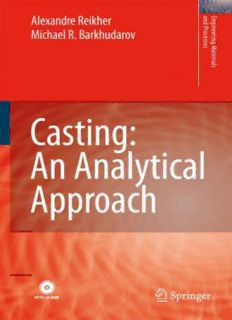Table Of ContentEngineering Materials and Processes
SeriesEditor
ProfessorBrianDerby,ProfessorofMaterialsScience
ManchesterMaterialsScienceCentre,GrosvenorStreet,Manchester,M17HS,UK
Othertitlespublishedinthisseries:
FusionBondingofPolymerComposites
C.AgeorgesandL.Ye
CompositeMaterials
D.D.L.Chung
Titanium
G.LütjeringandJ.C.Williams
CorrosionofMetals
H.Kaesche
CorrosionandProtection
E.Bardal
IntelligentMacromoleculesforSmartDevices
L.Dai
MicrostructureofSteelsandCastIrons
M.Durand-Charre
PhaseDiagramsandHeterogeneousEquilibria
B.Predel,M.HochandM.Pool
ComputationalMechanicsofCompositeMaterials
M.Kamin´ski
GalliumNitrideProcessingforElectronics,SensorsandSpintronics
S.J.Pearton,C.R.AbernathyandF.Ren
MaterialsforInformationTechnology
E.Zschech,C.WhelanandT.Mikolajick
FuelCellTechnology
N.Sammes
ComputationalQuantumMechanicsforMaterialsEngineers
L.Vitos
PublicationdueAugust2007
Alexandre Reikher and Michael R. Barkhudarov
Casting:
An Analytical
Approach
123
AlexandreReikher,PhD MichaelR.Barkhudarov,PhD
AlbanyChicagoCo. FlowScience,Inc.
8200100thSt. 683AHarkleRoad
PleasantPrairie,WI53158 SantaFe,NM87505
USA USA
BritishLibraryCataloguinginPublicationData
Reikher,Alexandre
Casting:ananalyticalapproach.-(Engineeringmaterials
andprocesses)
1.Founding
I.TitleII.Barkhudarov,MichaelR.
671.2
ISBN-13:9781846288494
LibraryofCongressControlNumber:2007928128
EngineeringMaterialsandProcessesISSN1619-0181
ISBN 978-1-84628-849-4 e-ISBN 978-1-84628-850-0 Printedonacid-freepaper
©Springer-VerlagLondonLimited2007
FAVOR™andFLOW-3D®aretrademarksandregisteredtrademarksofFlowScienceInc.,683Harkle
Rd.SteA,SantaFe,NM87505,USA.http://www.flow3d.com
MATLAB®isaregisteredtrademarkofTheMathWorks,Inc.,3AppleHillDrive,Natick,MA01760-2098,
USA.http://www.mathworks.com
Visual Basic® is a registered trademarkof MicrosoftCorporation, One MicrosoftWay, Redmond,
WA98052-6399,USA.http://www.microsoft.com
Thesoftwarediskaccompanyingthisbookandallmaterialcontainedonitissuppliedwithoutany
warrantyofanykind.Thepublisheracceptsnoliabilityforpersonalinjuryincurredthroughuseor
misuseofthedisk.
Apartfromanyfairdealingforthepurposesofresearchorprivatestudy,orcriticismorreview,as
permittedundertheCopyright,DesignsandPatentsAct1988,thispublicationmayonlybereproduced,
stored or transmitted, in any form or by any means, with the prior permission in writing of the
publishers,orinthecaseofreprographicreproductioninaccordancewiththetermsoflicencesissued
bytheCopyrightLicensingAgency.Enquiriesconcerningreproductionoutsidethosetermsshouldbe
senttothepublishers.
Theuseofregisterednames,trademarks,etc.inthispublicationdoesnotimply,evenintheabsenceof
aspecificstatement,thatsuchnamesareexemptfromtherelevantlawsandregulationsandtherefore
freeforgeneraluse.
Thepublishermakesnorepresentation,expressorimplied,withregardtotheaccuracyoftheinfor-
mationcontainedinthisbookandcannotacceptanylegalresponsibilityorliabilityforanyerrorsor
omissionsthatmaybemade.
9 8 7 6 5 4 3 2 1
SpringerScience+BusinessMedia
springer.com
Michael Barkhudarov:
I dedicate this work to my family, Natasha, Sophia and Philip,
and to my dear parents
Alexandre Reikher:
I dedicate this work
To my dear parents
To my wife Marianna
And to my children Daniel and Alison
Preface
This book is the result of 40 years of the combined authors’ experience in
mechanical and fluid dynamics engineering. It gives an overview of product and
process development from the analytical standpoint.
This book has not been intended to revolutionize the casting industry. The
principals of fluid dynamics and static mechanics were largely developed in the
nineteenth century, but process development still largely remains a trial and error
method. This book is intended to underline the principals of strength of materials
and fluid dynamics that are the foundation of the casting product and process
development.
This book has been written as a resource and design tool for product and
process engineers and designers who work with aluminium castings. It combines
many aspects of product and process development, which include the basic
principals of static mechanics and fluid dynamics as well as completely developed
applications allowing solving problems at every stage of the development process.
This book has five main parts: (1) overview of casting processes, (2) fluid
dynamics, (3) strength of materials, (4) sand casting, permanent mould, and die
casting process development, and (5) quality control.
The unique feature of this book is a combination of real life problems, which
product and process engineers face every day, with user-friendly applications
written in MATLAB® and Visual Basic. The comprehensive unit conversion
calculator as well as examples in the area of strength of materials is intended to
serve as a reference for practicing engineers as well as for students who are
beginning to study mechanical engineering. It cab also be used by process
engineers, who contribute greatly to product design.
Completely developed process design applications will help process engineers
to take full advantage of the power that computers and software bring to
engineering. Product engineers can also get inside of process development
procedures as well as the governing equations that are used in casting process
development.
Examples in this book are solved with the help of MATLAB® functions, Visual
Basic applications as well as a general purpose CFD code FLOW-3D®. All
MATLAB® functions, art work and Visual Basic applications are developed by the
viii Preface
authors. Proper references are given for commonly available equations and
theories.
Considerable effort has been made to avoid errors. The authors would
appreciate reader’s comments and suggestions for any corrections and
improvements to this book.
Alexandre Reikher, Milwaukee, Wisconsin, USA, April 2007
Michael Barkhudarov, Los Alamos, New Mexico, USA, April 2007
Contents
1 Casting of Light Metals....................................................................................1
1.1 Casting Processes.......................................................................................1
1.2 Sand Casting .............................................................................................1
1.2.1 Gating System................................................................................2
1.2.2 Risers and Chills.............................................................................2
1.3 Permanent Mould ......................................................................................3
1.3.1 Gravity Casting...............................................................................4
1.3.2 Low-pressure Permanent Mould Casting.......................................4
1.3.3 Counterpressure Casting.................................................................4
1.4 Die Casting................................................................................................5
1.4.1 Die-cast Process .............................................................................5
1.4.2 Die-cast Dies .................................................................................8
1.4.3 Runner System ...............................................................................8
1.4.4 Cavity of Die-cast Die .................................................................11
1.4.5 Air Ventilation System ................................................................11
1.4.6 Ventilation Blocks .......................................................................12
2 Introduction to Fluid Dynamics....................................................................13
2.1 Basic Concepts .......................................................................................13
2.1.1 Pressure ......................................................................................13
2.1.2 Viscosity ......................................................................................14
2.1.3 Temperature and Enthalpy ...........................................................16
2.2 Equations of Motion................................................................................18
2.3 Boundary Conditions...............................................................................19
2.3.1 Velocity Boundary Conditions at Walls.......................................20
2.3.2 Thermal Boundary Conditions at Walls.......................................20
2.3.3 Free Surface Boundary Conditions...............................................21
2.4 Useful Dimensionless Numbers...............................................................23
2.4.1 Definitions....................................................................................23
2.4.2 The Reynolds number...................................................................24
2.4.3 The Weber Number......................................................................24
x Contents
2.4.4 The Bond Number........................................................................25
2.4.5 The Froude Number......................................................................25
2.5 The Bernoulli Equation............................................................................26
2.6 Compressible Flow..................................................................................26
2.6.1 Equation of State..........................................................................27
2.6.2 Equations of Motion.....................................................................28
2.6.3 Specific Heats...............................................................................29
2.6.4 Adiabatic Processes......................................................................31
2.6.5 Speed of Sound.............................................................................31
2.6.6 Mach Number...............................................................................33
2.6.7 The Bernoulli Equation for Gases................................................33
2.7 Computational Fluid Dynamics...............................................................35
2.7.1 ComputationalMesh.....................................................................35
2.7.2 Numerical approximations...........................................................36
2.7.3 Representation of Geometry.........................................................38
2.7.4 Free Surface Tracking..................................................................39
2.7.5 Summary......................................................................................41
3 Part Design ......................................................................................................43
3.1 Design of Light Metal Castings...............................................................43
3.2 Static Analysis .......................................................................................43
3.2.1 Moment of an Area.......................................................................44
3.2.2 Moment of Inertia of an Area.......................................................44
3.3 Loading .................................................................................................46
3.4 Stress Components...................................................................................47
3.4.1 Linear Stress.................................................................................48
3.4.2 Plane Stress...................................................................................50
3.4.3 Mohr’s Circle................................................................................51
3.5 Hooke’s Law............................................................................................55
3.6 Saint-Venant’s Principle..........................................................................56
3.7 Criteria of Failure.....................................................................................57
3.7.1 Ductile Material Failure Theory..................................................58
3.7.2 Brittle Material Failure Theory....................................................58
3.8 Beam Analysis ........................................................................................58
3.8.1 Free Body Diagram......................................................................67
3.8.2 Reactions......................................................................................67
3.9 Buckling .......................................................................................68
3.10 Bending Stresses......................................................................................71
3.10.1 Normal Stresses in Bending.........................................................72
3.10.2 Shear Stress..................................................................................74
3.11 Stresses in Cylinders................................................................................76
3.12 Press-fit Analysis.....................................................................................82
3.13 Thermal Stresses......................................................................................86
3.14 Torque......................................................................................................87
3.15 Stress Concentration................................................................................93
Description:For a long time, the die cast industry has used trial and error as a leading development method, resulting in tremendous growth in the utilisation of available CFD (computational fluid dynamics) software. This software allows the development of better products that maximise the advantages the die ca

